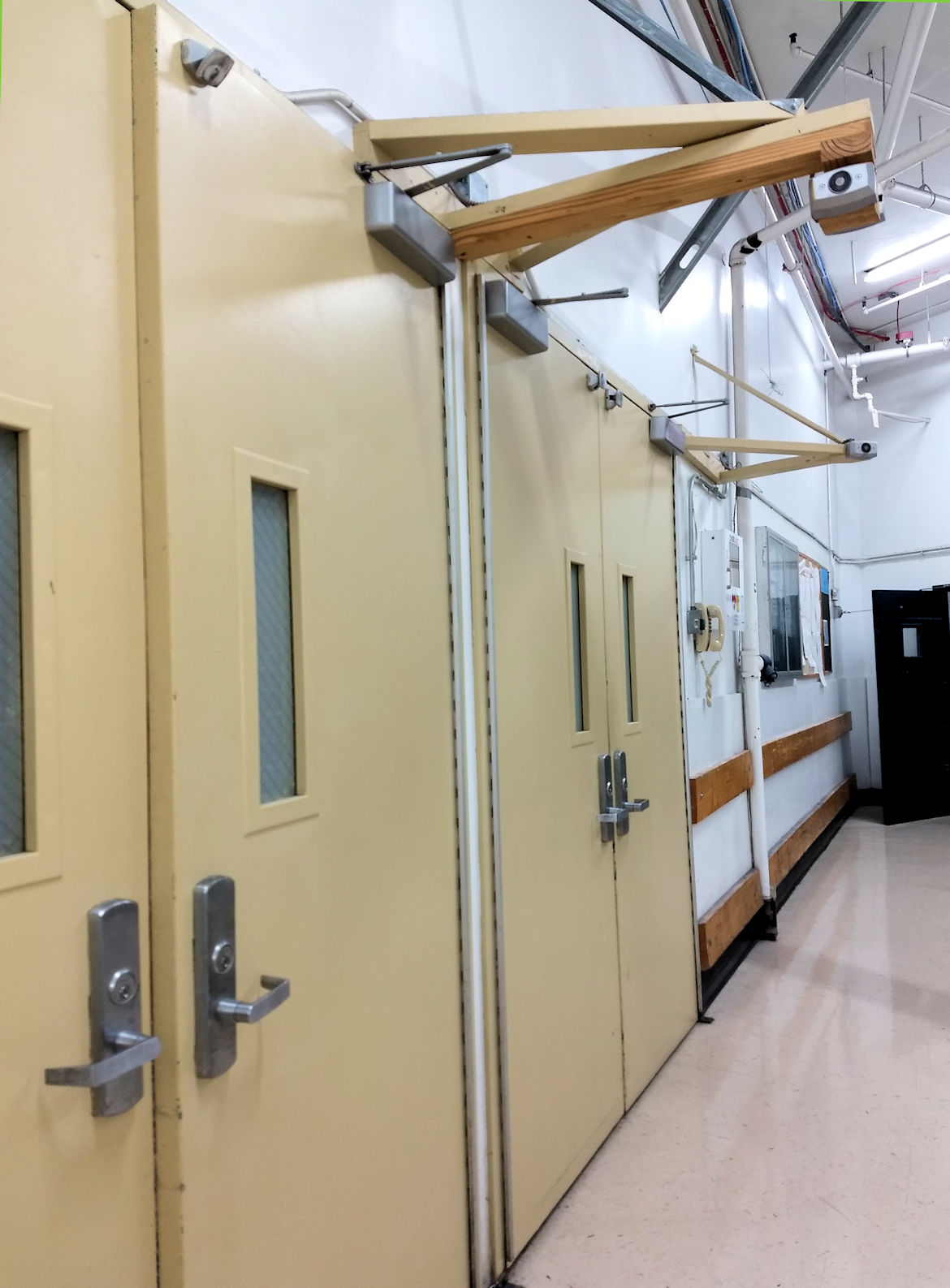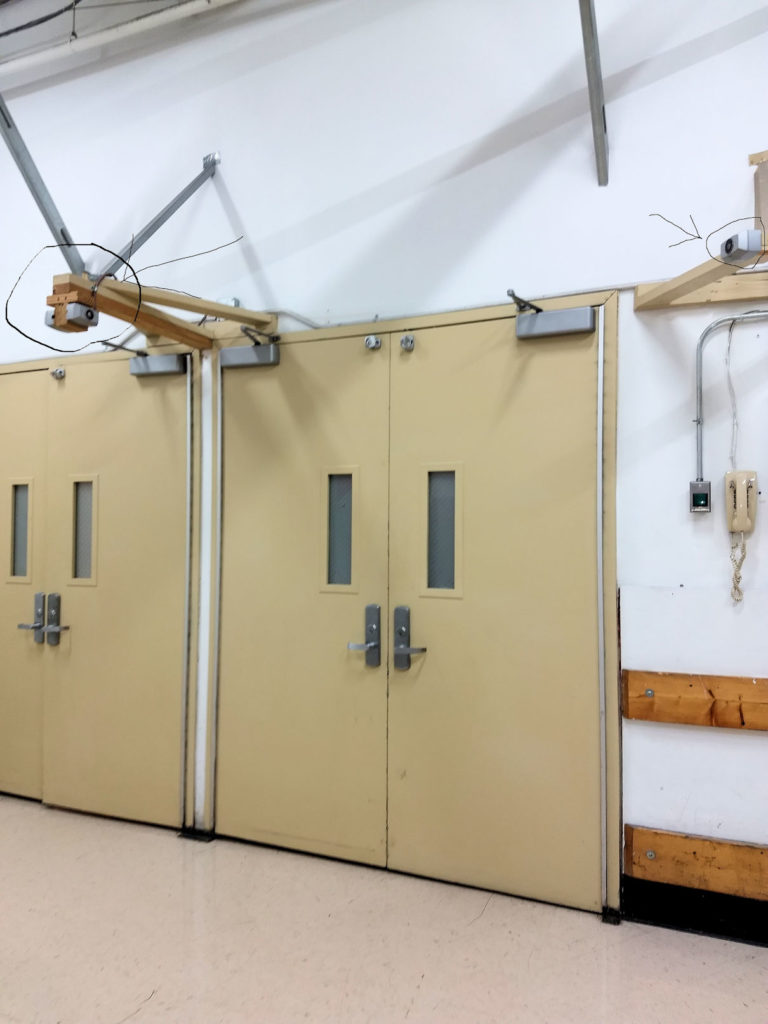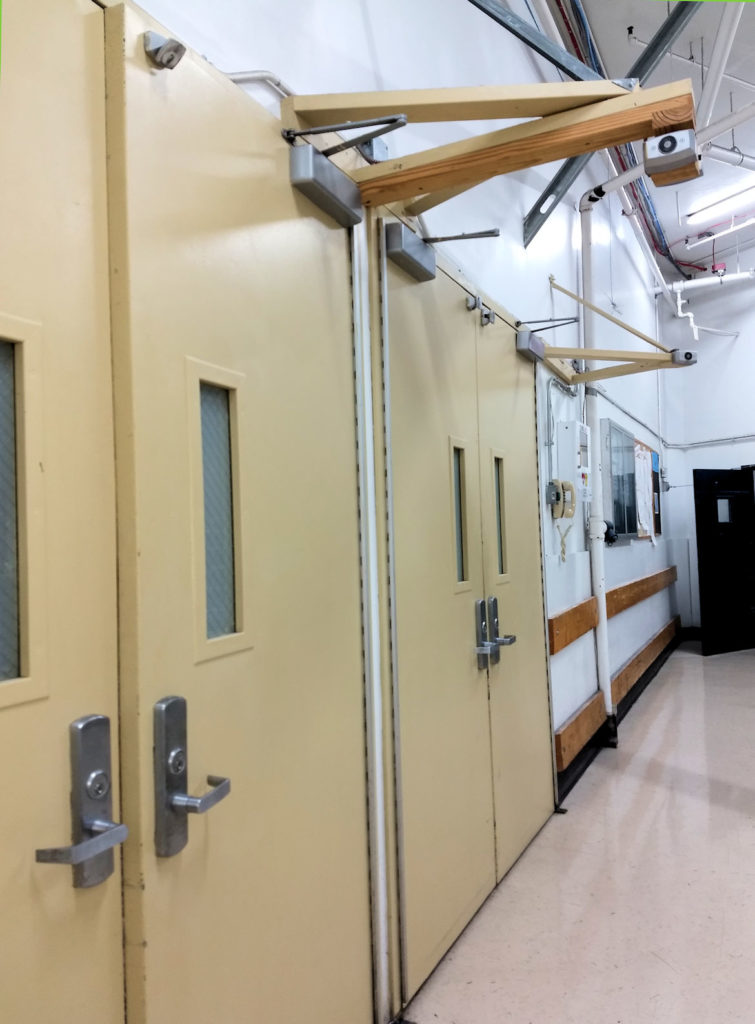These Fixed-it Friday photos came from Steve Griffis at Federal Lock & Safe. Steve was questioning the legality of this application (he’s not responsible for this installation). Although it’s not one of the most beautiful solutions that I’ve seen, I couldn’t think of a code issue as long as the hold-opens are above the minimum clear headroom of 80 inches. What do you think?
We may see banks of doors with hold-opens more often, as schools consider how to compartmentalize the building for security. Cross-corridor doors and doors to assembly spaces could be kept locked but held open – during a lockdown, one switch would release the magnetic holders and the doors would close. Since the levers are already in the locked position, the doors will be locked to prevent access as soon as they are closed (still allowing free egress, of course). There is a better way to hold open a bank of doors, and I wrote a blog post about it here.
I need a favor! I’ve been having trouble with the spam blocker when people submit comments. If some of you would leave a comment, that will help me test out the fix. If you have trouble commenting, please send me an email and tell me what happened.
You need to login or register to bookmark/favorite this content.









Probably code compliant but just plain ugly, and whoever designed them should be embarrassed!
At your request and in reply, if those are standard 80-inch tall doors, the headroom clearance conflict would be in play.
I think these are probably 84-inch doors but yes – if they were 80 inches tall the wood and magnetic holders would project too low into the required headroom.
– Lori
I question the wood being used, but another problem I see is the brown door in the background has an armature plate attached to a chain, when it’s releasted it will swing in an arc in hit someone in the face, I see this done all to often, both poor installations. I would have upgraded to a track arm and saved on design and labor.
Looks like a strong, well engineered rig and a good solution on likely a very low budget. Better to spend the money on text books. As long as the junction box meets the 50 lb. minimum pull, the manufacturer’s fasteners, etc. are used, and the electrical inspects true then mission accomplished. This problem solver may have made a call to the factory to verify that this unique installation was ok as well. Surely it will be forced to pass an inspection at some point.
This rig appears to be part of a series of “Handyman Corner” type engineering and repair efforts attempting to address a poorly designed door assembly and bring it into temporary compliance.
SEE https://www.youtube.com/watch?v=n4RY0j54Ikg for a good laugh on “Handyman Corner” methods of repair.
It makes for good entertainment but it’s a waste of time and money. Perhaps it would be clever and resourceful if it resulted in a solid reliable operating door assembly, but this is clearly NOT the case.
It all starts with the door frames. You can’t hang doors on flimsy or poorly attached frames and expect them to operate consistently. Judging only by what can be seen in these pictures:
1 – The left pair of doors not fully closing and latching.
2 – The meeting points of both pairs where paint has been scratched or rubbed off entirely indicating that they likely must be pushed closed or have the closers cranked up to full strength effectively slamming the doors and ignoring ADA standards.
3 – The gaps in the upper corner of the knockdown frames indicate that the frame are likely loose and moving around with every door cycle. The may be missing the corner fasteners and caulking. Fully welded frames securely fastened to the wall assembly and anchored to the concrete would be suitable for doors like these.
4 – The steel brackets added at the base of all the frame legs. This is likely an attempt to secure loose frames that have been moving around from day one.
I have seen many similar repairs. I would guess that many, many man hours and hundreds, possibly thousands, of maintenance dollars have been poured into these door assemblies. The result is still an ugly installation and two sets of doors with ongoing operational issues. I would bet that these doors require constant tweaking to close and latch properly. This rig might satisfy an AHJ in the moment but I highly doubt it reliably serves the intended operation. The codes often address design concerns that have already caused injury or death. In my view, an assessment of code compliance needs to examine the intent of the code. The code’s intended objective is a door assembly that allows free egress, prevents the spread of fire, and secures the space. These doorways only appear to reliably accomplish one of those three objectives.
Thanks for sharing your insight, David! I really appreciate it.
– Lori
should have used the 4040SE
I agree with Alex, the 4040SE by lcn would have been a whole lot cleaner than this abomination. the magnet on the ajar door is not going work in the position its in. im assuming these are labeled openings. or the CPSH arm would suffice.
Thank you for the useful article.